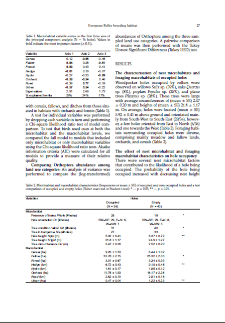- Wyszukaj w całym Repozytorium
- Piśmiennictwo i mapy
- Archeologia
- Baza Młynów
- Nauki przyrodnicze
Wyszukiwanie zaawansowane
Wyszukiwanie zaawansowane
Wyszukiwanie zaawansowane
Wyszukiwanie zaawansowane
Wyszukiwanie zaawansowane

Obiekt
Tytuł: Effects of Forest Management on Three-toed Woodpecker Picoides tridactylus Distribution in the Białowieża Forest (NE Poland): Conservation Implications
Twórca:
Wesołwski, Tomasz ; Czeszczewik, Dorota ; Rowiński, Patryk
Data wydania/powstania:
Typ zasobu:
Inny tytuł:
Wpływ gospodarki leśnej na rozmieszczenie dzięcioła trójpalczastego w Puszczy Białowieskiej: konsekwencje dla ochrony gatunku ; Effects of forest management on Three-toed Woodpecker
Współtwórca:
Museum and Institute of Zoology, Polish Academy of Sciences
Wydawca:
Museum and Institute of Zoology, Polish Academy of Sciences
Miejsce wydania:
Opis:
Typ obiektu:
Abstrakt:
Distribution of Three-toed Woodpeckers and that of dead wood were mapped in two fragments of the Białowieża National Park (BNP) differing in their management history — primeval (old-growth stands of natural origin, no human intervention) and logged (as the former but subject to 80 years of commercial forestry). Data were collected during the breeding seasons 1999–2001. In the end of April 2000, the whole BNP was systematically searched; playbacks of drumming were used to enhance detection of birds. Presence/absence of Three-toed Woodpeckers and of dead wood (standing and downed Norway spruces and snags of other trees) were recorded within each forest sub-compartments (ca. 28 ha). Data from censuses done in smaller plots in 1975–1999 showed that in the primeval forest the woodpeckers bred twice more frequently in swampy and coniferous forests than in the oak-hornbeam habitat. These preferred habitat types covered larger areas in the logged fragment than in the primeval part (66% vs. 41%). Yet despite this, Three-toed Woodpeckers were recorded there over twice less frequently (14% of 176 sub-compartments) than in the primeval (36% of 164 sub-compartments) part. These differences followed sharp contrasts in the dead wood availability; all but one sub-compartments in the primeval fragment contained some form of dead wood, whereas dead spruces were missing in almost 30% of sub-compartments in the logged part. This was the effect of continuous “sanitary” logging, purposeful removal of dying and dead spruces from the Forest. To restore Three-toed Woodpecker habitats it is necessary to ban removal of dead spruces in the managed part of BNP. However, the BNP area is too small, to assure the long-term survival of the Białowieża Forest population. To achieve this, it is necessary to resign from removal of dying and dead spruces in the whole Polish part of the Białowieża Forest (600 km2). This would create breeding habitat for a maximum 260–320 pairs.
Czasopismo/Seria/cykl:
Tom:
Zeszyt:
Strona pocz.:
Strona końc.:
Szczegółowy typ zasobu:
Format:
Identyfikator zasobu:
oai:rcin.org.pl:55532 ; 10.3161/068.040.0111
Źródło:
MiIZ PAN, sygn. P.257 ; MiIZ PAN, sygn. P.4568
Język:
Język streszczenia:
Prawa:
Prawa zastrzeżone - dostęp nieograniczony
Zasady wykorzystania:
Digitalizacja:
Muzeum i Instytut Zoologii Polskiej Akademii Nauk
Lokalizacja oryginału:
Biblioteka Muzeum i Instytutu Zoologii PAN
Dofinansowane ze środków:
Program Operacyjny Innowacyjna Gospodarka, lata 2010-2014, Priorytet 2. Infrastruktura strefy B + R ; Unia Europejska. Europejski Fundusz Rozwoju Regionalnego
Dostęp:
Kolekcje, do których przypisany jest obiekt:
- Repozytorium Cyfrowe Instytutów Naukowych > Kolekcje Partnerów > Muzeum i Instytut Zoologii PAN > Czasopisma
- Repozytorium Cyfrowe Instytutów Naukowych > Kolekcje Partnerów > Muzeum i Instytut Zoologii PAN > Wydawnictwa MiIZ PAN > Acta Ornithologica
- Repozytorium Cyfrowe Instytutów Naukowych > Piśmiennictwo > Czasopisma/Artykuły
Data ostatniej modyfikacji:
4 lut 2025
Data dodania obiektu:
28 lip 2015
Liczba pobrań / odtworzeń:
33
Wszystkie dostępne wersje tego obiektu:
https://rcin.org.pl./publication/75762
Wyświetl opis w formacie RDF:
Wyświetl opis w formacie RDFa:
Wyświetl opis w formacie OAI-PMH:
Obiekty Podobne
Wesołowski, Tomasz Rowiński, Patryk Mitrus, Cezary Czeszczewik, Dorota
Skubała, Piotr Duras, Marta
Schmidt, K.
Roman, G.
Wołk, E. Wołk, K.
Miłkowski, L. Wójcik, J. M.
Okarma, H. Jedrzejewski, W. Schmidt, K. Kowalczyk, R. Jedrzejewska, B.

 INSTYTUT ARCHEOLOGII I ETNOLOGII POLSKIEJ AKADEMII NAUK
INSTYTUT ARCHEOLOGII I ETNOLOGII POLSKIEJ AKADEMII NAUK
 INSTYTUT BADAŃ LITERACKICH POLSKIEJ AKADEMII NAUK
INSTYTUT BADAŃ LITERACKICH POLSKIEJ AKADEMII NAUK
 INSTYTUT BADAWCZY LEŚNICTWA
INSTYTUT BADAWCZY LEŚNICTWA
 INSTYTUT BIOLOGII DOŚWIADCZALNEJ IM. MARCELEGO NENCKIEGO POLSKIEJ AKADEMII NAUK
INSTYTUT BIOLOGII DOŚWIADCZALNEJ IM. MARCELEGO NENCKIEGO POLSKIEJ AKADEMII NAUK
 INSTYTUT BIOLOGII SSAKÓW POLSKIEJ AKADEMII NAUK
INSTYTUT BIOLOGII SSAKÓW POLSKIEJ AKADEMII NAUK
 INSTYTUT CHEMII FIZYCZNEJ PAN
INSTYTUT CHEMII FIZYCZNEJ PAN
 INSTYTUT CHEMII ORGANICZNEJ PAN
INSTYTUT CHEMII ORGANICZNEJ PAN
 INSTYTUT FILOZOFII I SOCJOLOGII PAN
INSTYTUT FILOZOFII I SOCJOLOGII PAN
 INSTYTUT GEOGRAFII I PRZESTRZENNEGO ZAGOSPODAROWANIA PAN
INSTYTUT GEOGRAFII I PRZESTRZENNEGO ZAGOSPODAROWANIA PAN
 INSTYTUT HISTORII im. TADEUSZA MANTEUFFLA POLSKIEJ AKADEMII NAUK
INSTYTUT HISTORII im. TADEUSZA MANTEUFFLA POLSKIEJ AKADEMII NAUK
 INSTYTUT JĘZYKA POLSKIEGO POLSKIEJ AKADEMII NAUK
INSTYTUT JĘZYKA POLSKIEGO POLSKIEJ AKADEMII NAUK
 INSTYTUT MATEMATYCZNY PAN
INSTYTUT MATEMATYCZNY PAN
 INSTYTUT MEDYCYNY DOŚWIADCZALNEJ I KLINICZNEJ IM.MIROSŁAWA MOSSAKOWSKIEGO POLSKIEJ AKADEMII NAUK
INSTYTUT MEDYCYNY DOŚWIADCZALNEJ I KLINICZNEJ IM.MIROSŁAWA MOSSAKOWSKIEGO POLSKIEJ AKADEMII NAUK
 INSTYTUT PODSTAWOWYCH PROBLEMÓW TECHNIKI PAN
INSTYTUT PODSTAWOWYCH PROBLEMÓW TECHNIKI PAN
 INSTYTUT SLAWISTYKI PAN
INSTYTUT SLAWISTYKI PAN
 SIEĆ BADAWCZA ŁUKASIEWICZ - INSTYTUT TECHNOLOGII MATERIAŁÓW ELEKTRONICZNYCH
SIEĆ BADAWCZA ŁUKASIEWICZ - INSTYTUT TECHNOLOGII MATERIAŁÓW ELEKTRONICZNYCH
 MUZEUM I INSTYTUT ZOOLOGII POLSKIEJ AKADEMII NAUK
MUZEUM I INSTYTUT ZOOLOGII POLSKIEJ AKADEMII NAUK
 INSTYTUT BADAŃ SYSTEMOWYCH PAN
INSTYTUT BADAŃ SYSTEMOWYCH PAN
 INSTYTUT BOTANIKI IM. WŁADYSŁAWA SZAFERA POLSKIEJ AKADEMII NAUK
INSTYTUT BOTANIKI IM. WŁADYSŁAWA SZAFERA POLSKIEJ AKADEMII NAUK




































